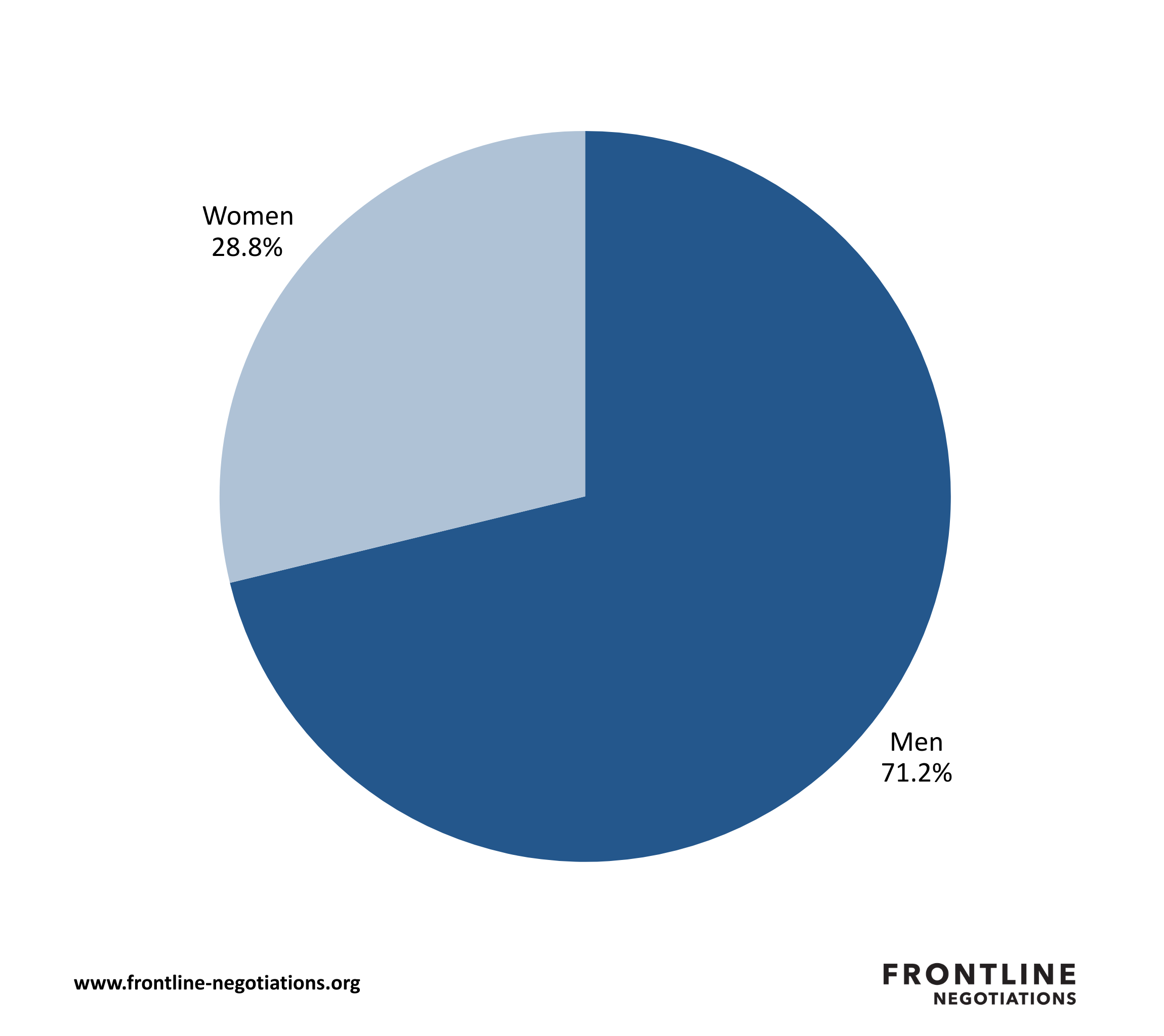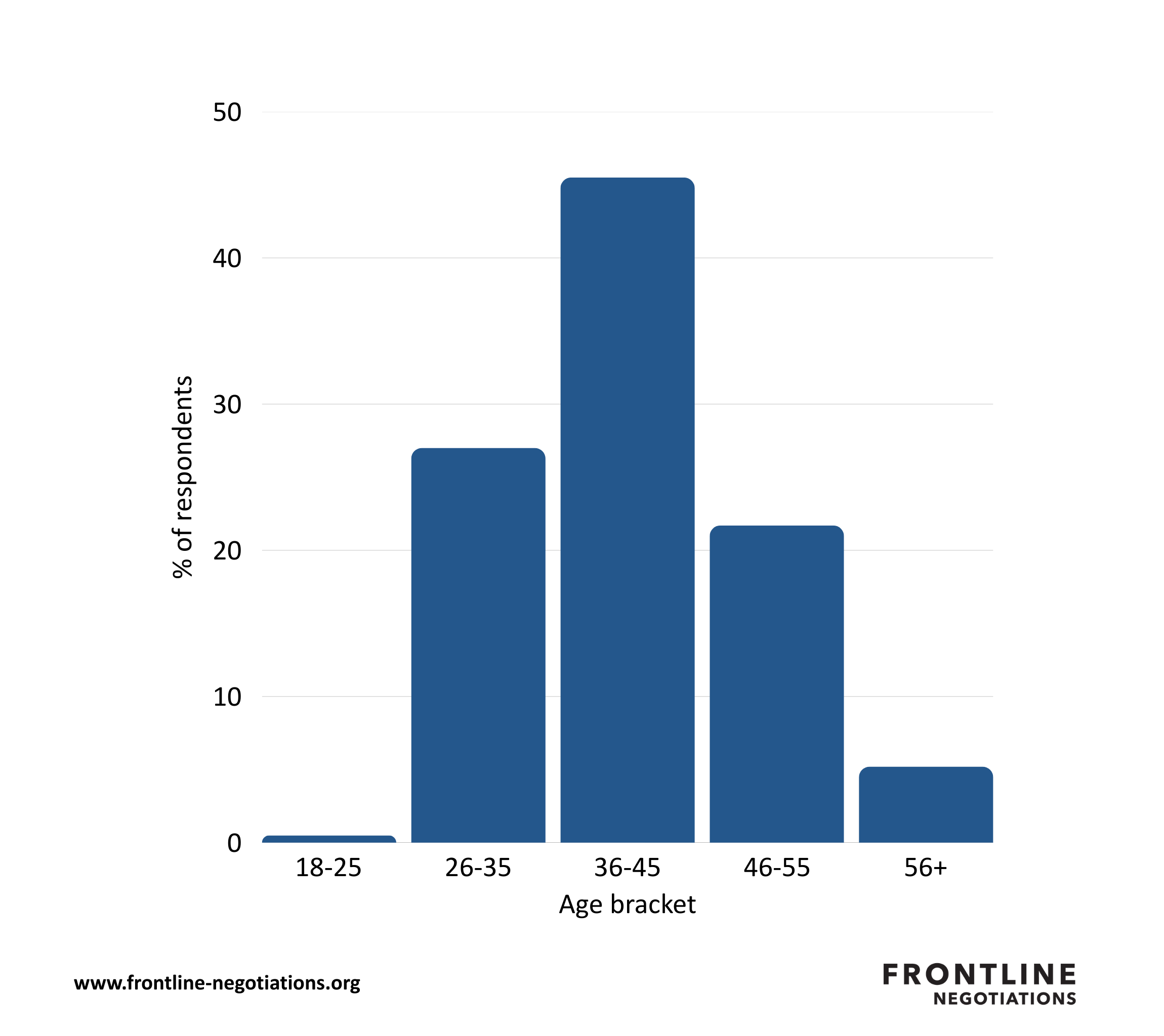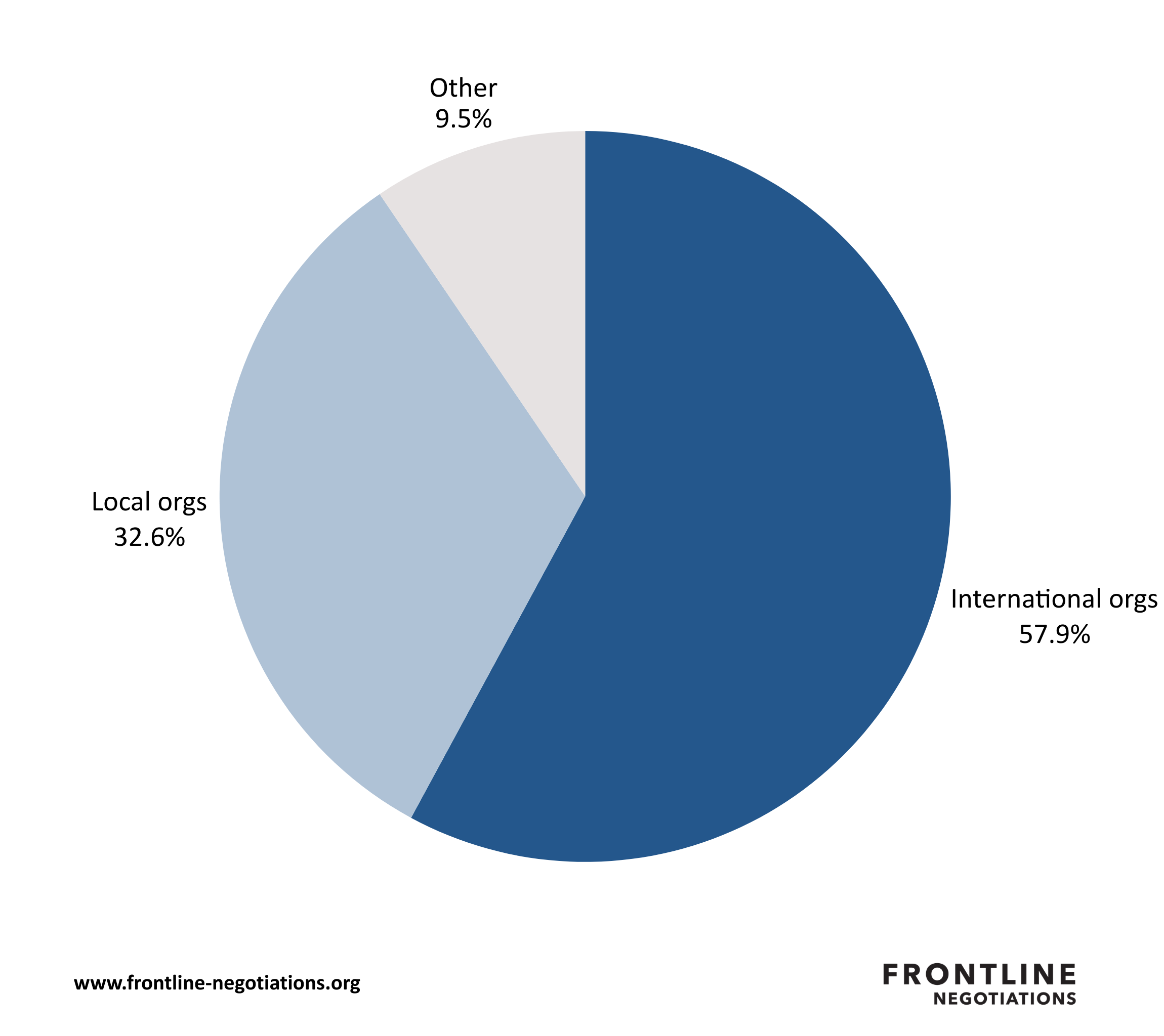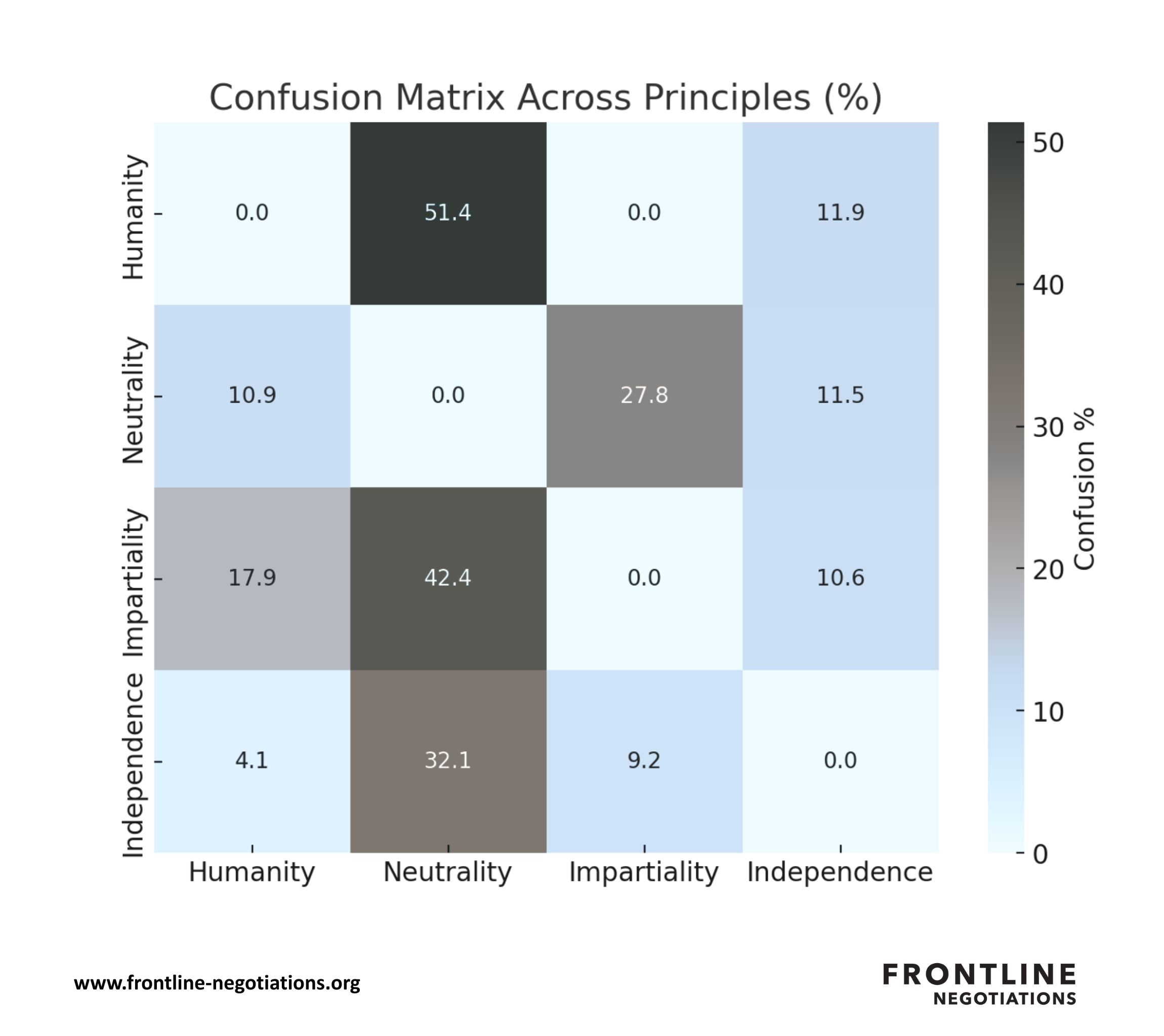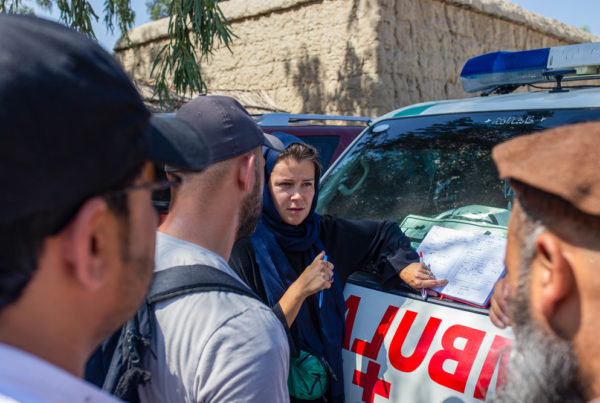
Humanitarian principles are at the core of frontline negotiation.
They guide, support, and enable humanitarian action, serving as both an ethical compass and an operational framework, including negotiations for humanitarian access.
However, implementing and protecting these principles is not simple.
Humanitarian staff must first develop a deep understanding of these principles. Applying them requires navigating the complexities of humanitarian contexts while balancing the urgency to deliver aid.
Additionally, many negotiators do not necessarily share a common understanding of the principles and, in some cases, have inaccurate definitions. Without a solid grasp of the principles, their definitions, and their functions, their application can be inconsistent or even absent.
As a result, humanitarian negotiators often hold differing views on how these principles should be applied.
The CCHN launched a research stream to answer the following questions:
- How well do negotiators understand the humanitarian principles?
- Does their understanding help in applying the humanitarian principles in operations?
- How do aid workers put the humanitarian principles into practice in negotiations?
To address these questions, the CCHN surveyed over 380 humanitarian professionals to evaluate how well humanitarian principles are understood and applied in negotiations.
By the end of this blog, you’ll discover how well humanitarians understand the principles, which definitions cause the most confusion, and what these findings mean for the application of humanitarian principles in negotiations.
What are humanitarian principles?
The four fundamental humanitarian principles are:
- Humanity: The belief that human suffering must be addressed wherever found.
- Impartiality: The belief that assistance must be provided based on need alone, giving priority to the most urgent cases without distinction.
- Neutrality: The belief that organisations must refrain from taking sides in hostilities, and
- Independence: The belief that assistance must be autonomous from political, economic, military, or other objectives.
These fundamental principles were first established by the International Red Cross and Red Crescent Movement (RCRC) and later reaffirmed in UN General Assembly resolutions and enshrined in numerous humanitarian standards and guidelines.
Why humanitarian principles matter
In contexts of armed conflict and extreme violence, where factions abound and friction between them can lead to escalation, humanitarian principles serve several crucial purposes:
- They provide a framework—for all actors involved—that supports the idea that human suffering must be addressed wherever it is found, no matter how grave or violent the situation.
- They frame humanitarian organisations’ work as impartial, focusing on providing assistance to the most urgent cases, no matter their allegiance.
- They protect humanitarian staff by positioning them as not taking sides in the hostilities, allowing them into active conflict zones as neutral actors.
- They help build trust by stating that humanitarian aid must be independent of political, economic, military, or other objectives.
How principles guide humanitarian negotiations
Humanitarian principles serve as an ethical and operational framework for humanitarian action, including negotiations with armed groups, authorities or even communities.
While their practice is vital for humanitarians to carry out their work and secure humanitarian access, interpreting them practically can be a challenge. For this reason, humanitarians often need to negotiate them to help affected communities.
Consistently applying humanitarian principles can contribute to organisations’ positive reputation. Being perceived as a trustworthy and reliable partner may allow humanitarians to more easily open dialogue with armed groups, the military, and local communities, and help build long-term relationships with these actors.
Finally, when aid workers correctly understand the humanitarian principles and how to apply them in humanitarian negotiations, they can make more thoughtful, decisive decisions, allowing them to respond quickly to emergencies and facilitate humanitarian relief operations.
Why applying these principles can be so challenging
If correctly applying humanitarian principles improves operational efficiency and humanitarian access, and failing to do so can have severe consequences, why is it so difficult to put these principles into practice?
One major challenge is ensuring that humanitarian staff not only understand the principles but also apply them consistently. Achieving this requires robust onboarding and ongoing training, which can be particularly difficult for local organisations with limited resources.
Even when definitions of the principles are clear, our research shows that this does not always lead to smooth or consistent application. When interpretation is left up to individuals, inconsistencies and confusion often arise.
Practical dilemmas further complicate matters. For example, what does neutrality mean in an organisation primarily staffed by members of a local ethnic group? How can independence be upheld when funding is tied to donor agendas?
Without translating principles into clear, actionable behaviours, humanitarian negotiators may struggle to build arguments and reach compromises that uphold core values while still securing access for those in need.
Negotiators often find it difficult to express principles in straightforward, accessible language, especially when engaging with counterparts unfamiliar with international humanitarian law or the humanitarian sector. Applying theoretical frameworks to urgent, real-world situations can be particularly demanding.
When the principles are poorly understood, or there is little guidance on how to put them into practice, negotiators may bend under pressure to relieve suffering or become overly accommodating, sacrificing essential red lines. Such compromises not only put staff and operations at risk but also set dangerous precedents for the wider humanitarian community.
In the pursuit of rapid access in urgent situations, negotiators may inadvertently undermine humanitarian principles, jeopardising the long-term viability of operations and compromising humanitarian space.
How well do aid workers understand the principles?
The CCHN conducted a survey of more than 380 humanitarian professionals to assess their understanding and application of humanitarian principles in negotiations.
Among the top 10 countries represented, half were in Africa, with the Democratic Republic of the Congo as the most represented nation. The majority of respondents were male.
Most participants were established professionals, primarily aged 36 to 45, followed by those aged 26 to 35.
Respondents predominantly worked for international agencies, including the United Nations, with local non-governmental organisations also well represented.
Key findings: Understanding vs. application
Let’s find out how well humanitarians understand the principles, which definitions cause the most confusion, which are most often misunderstood, and what these results mean for their application in humanitarian negotiations.
1. Humanity: The most misunderstood principle
Overall, people struggled to connect human dignity and the humanitarian imperative with the principle of humanity.
This is not just an issue due to national contexts or the type of organisation. Our results indicate this is a widespread gap in humanitarian training.
In sum, respondents often confuse humanity and its main element, dignity, with impartiality, which focuses on delivering assistance and protection based on the most urgent needs.
2. Neutrality: The go-to principle
Neutrality emerged as the “magnet of confusion” among respondents.
When unsure, many defaulted to neutrality as their preferred answer.
For example, in instances where ‘humanity’ was the correct response, over half (51.4%) mistakenly selected neutrality.
Respondents also chose neutrality over impartiality 42.4% of the time and over independence 32.1% of the time.
This trend may stem from practitioners conflating fairness or impartiality with not taking sides, or from neutrality being the most frequently referenced principle in negotiation arguments.
3. The theory-practice gap
The results reveal a clear gap between theoretical understanding and practical application.
While most respondents demonstrated a solid grasp of humanitarian principles, scoring an average of 71% on definitional questions, this familiarity did not translate into real-world situations, where correct responses dropped to just 48%.
Age emerged as a significant factor: younger professionals (26–35 years old) performed best, with 58.79% correct on application scenarios, while those aged 56 and older scored lowest, averaging 47.86%.
Gender, however, did not play a meaningful role; women answered correctly 56.29% of the time, and men 56.14%.
Case studies
Country-level insights
A striking country-level contrast emerged in the survey results. In Ethiopia and Sudan, an equal number of respondents (24 each) participated, with a similar split between international (60%) and local (40%) organisations.
The comparison revealed significant differences: participants from Ethiopia scored an average of 69% correct answers, while those from Sudan managed only 47%.
| Country | Average Score (%) |
| Ethiopia | 69 |
| Yemen | 60 |
| Cameroon | 58 |
| Burkina Faso | 56 |
| Nigeria | 56 |
| Syria | 56 |
| Afghanistan | 55 |
| Democratic Republic of the Congo | 54 |
| Myanmar (formerly Burma) | 52 |
| Sudan | 47 |
Digging deeper, two principles stood out. Respondents based in Ethiopia excelled in understanding the principle of humanity (61% correct), well above the survey average of 50%.
In contrast, respondents working in Sudan struggled with the principle of independence, scoring just 29%.
| Country | Humanity | Neutrality | Impartiality | Independence |
| Ethiopia | 61% | 56% | 48% | 51% |
| Sudan | 37% | 45% | 34% | 29% |
These divergent outcomes suggest that local context may deeply influence how humanitarian principles are understood and applied.
Questions remain: Does context shape interpretation? Do negotiation types or counterpart profiles play a role? The next research phase will use qualitative interviews to explore these differences in more depth.
Organisational insights
Respondents affiliated with the Red Cross and Red Crescent Movement consistently outperformed others on both definition and application questions.
Their strong results did not correlate with age or country context, pointing to one key differentiator: the organisation itself.
Further questions and reflections
These findings raise several important questions for the humanitarian community:
- What drives the gap between knowing and applying humanitarian principles in practice?
- Why does neutrality remain the default principle, sometimes at the expense of humanity and impartiality?
The CCHN will continue to investigate these and other critical issues as our research on humanitarian principles and negotiations evolves. If you are interested in collaborating, please reach out to [email protected].
Key takeaways
Applying humanitarian principles correctly not only improves operational efficiency but also strengthens humanitarian access. Neglecting them can have serious consequences for humanitarian operations and the protection of civilians.
To ensure effective implementation, all humanitarian staff need a clear understanding of each principle, the behaviours they entail, and decision-making frameworks that put them into day-to-day practice.
Our research shows that while most humanitarians can accurately define the principles, they often struggle to apply them, especially in conflict situations.
There is a tendency to default to neutrality and independence, leaving humanity and impartiality less frequently articulated and inconsistently applied. Negotiators, in particular, may over-rely on neutrality when advocating for the needs and dignity of affected communities.
Ultimately, a tension persists between the motivations driving humanitarian action and the practical realities on the ground. In challenging scenarios, compliance, access, and presence may take precedence over upholding the dignity and needs of affected people.
We hope these insights are valuable. Watch this space for updates from the next phase of our research.

